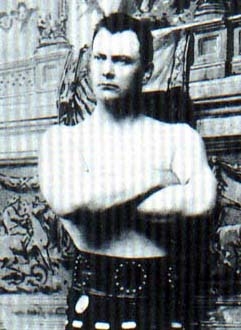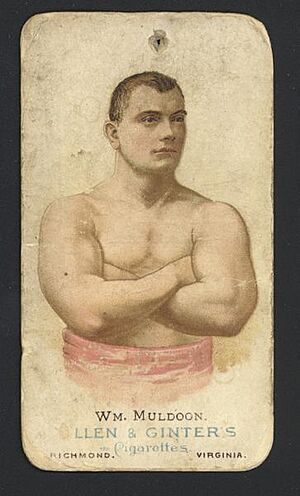William Muldoon facts for kids
Quick facts for kids William Muldoon |
|
|---|---|

Muldoon ca. 1885
|
|
| Born | May 25, 1852 Caneadea, New York, U.S. |
| Died | June 3, 1933 (aged 81) Purchase, New York, U.S. |
| Professional wrestling career | |
| Ring name(s) | Bill Muldoon |
| Billed height | 5 ft 10 in (178 cm) |
| Billed weight | 192–212 lb (87–96 kg) |
| Debut | 1870 (amateur) 1876 (semi-pro) 1881 (pro) |
| Retired | March, 1890 |
William Muldoon (May 25, 1852 – June 3, 1933) was a famous American Greco-Roman Wrestling champion. He was also a physical culturist, meaning he focused on improving physical health and strength. Muldoon became the first chairman of the New York State Athletic Commission, which oversees sports like boxing. He was known for his incredible strength and once wrestled a match that lasted over seven hours!
People called Muldoon "The Solid Man" because he was so strong and reliable. He became a champion in Greco-Roman wrestling in the 1880s. Over the years, he gained a lot of public respect. This continued when he owned a health farm in Westchester County and served on the NYSAC. Muldoon was a major figure in New York sports for more than 50 years.
Contents
William Muldoon's Early Life
William Muldoon was born in Allegany County, New York. His parents, Patrick Muldoon and Maria Donahoe, were immigrants from Ireland. His father worked as a farmer. From a young age, Muldoon showed a natural talent for sports that needed strength.
He became known locally for being great at caber-tossing, weightlifting, sprinting, and amateur wrestling. As a young man, he had a strong personality and wanted to be treated like an adult.
In 1870, Muldoon traveled to Paris to join the French Army as a volunteer. This was during the Franco-Prussian War. There, he met a publisher named James Gordon Bennett, Jr.. Bennett told Muldoon that he could become the best Greco-Roman wrestler in the world if he focused on it.
By 1876, Muldoon was living in New York City. He joined the New York Police Department with the help of Senator John Morrissey. Morrissey was a former bare-knuckle boxing champion. Muldoon worked as a detective before he left the police force in 1881.
Becoming "The Solid Man"
In 1880, William Muldoon became very famous. He won the World Greco-Roman Heavyweight Championship by defeating Thiebaud Bauer. After this, wrestlers from all over the world wanted to challenge him. Some of these challengers included Edwin Bibby and Tom Cannon from England, Donald Dinnie from Scotland, and "Mat" Sorakichi from Japan.
One of his most famous matches was in 1881 against Clarence Whistler. This incredible match lasted for seven hours! Neither wrestler could win a single fall.
After this celebrated match, Muldoon put together a group of athletes. They toured the country, putting on sports events and Muldoon defended his wrestling title. Around this time, Muldoon also started acting because of his fame. In 1883, he appeared in a play by William Shakespeare called As You Like It. He played the character Charles the Wrestler. In 1887, he performed on Broadway in a play called Spartacus.
In 1889, Muldoon helped train the famous boxer John L. Sullivan. Sullivan was preparing for a huge 75-round fight against Jake Kilrain. This fight was for the world heavyweight bare-knuckle boxing championship. Muldoon had made a friendly bet and offered to pay for everything if Sullivan lost. Sullivan won the fight, and Muldoon became nationally famous for getting the boxing champion back into top shape. People were very interested in Muldoon's training methods.
On May 28, Muldoon and Sullivan had an exhibition wrestling match. It ended in a 5-5 draw. Later, they had another three-round match, and Muldoon won two of the three rounds.
William Muldoon was never defeated for his Greco-Roman Championship. His last championship match was in 1890 in Philadelphia, where he defeated Evan Lewis. Even though promoters and challengers asked him to return, Muldoon never wrestled another official match. He symbolically passed his World Greco-Roman Heavyweight Championship to his student, Ernest Roeber. Muldoon's final public appearance as a wrestler was in a charity exhibition match against Roeber at Madison Square Garden in 1894.
That same year, Muldoon moved his health farm from Belfast, New York, to White Plains. As he stepped back from professional sports, he spent more time developing his system for improving people's health. Muldoon continued to train boxers and wrestlers until boxing was made illegal in New York around 1900.
Muldoon's Later Years and Health Work
In 1900, Muldoon opened his most important project: a famous health institute called The Olympia in Purchase, New York. In the years that followed, The Olympia became very successful. Muldoon again gained national attention as he helped many famous people. These included U.S. Ambassador to Great Britain Joseph Hodges Choate, publisher Ralph Pulitzer, and Secretary of State Elihu Root. President Teddy Roosevelt even sent Elihu Root to Muldoon for treatment.
In 1907, there was talk that Muldoon might be appointed to the president's cabinet to oversee physical health. Because of his strict methods at his health farm, people called Muldoon "the Professor." The famous journalist Nellie Bly was the first woman to complete Muldoon's health program.
In the spring of 1909, Muldoon returned to the stage one last time for a theater tour. The tour was organized to benefit a club called The Lambs. In 1915, Muldoon dedicated a Civil War monument in Belfast, New York. It listed the names of local veterans, including his older brother John.
In 1921, Governor Nathan Lewis Miller personally chose Muldoon to be the first Chairman of the New York State Athletic Commission. This happened when professional boxing was made legal again in New York. While on the NYSAC, Muldoon's strong and firm decisions showed his honest approach to the press and sports fans. Newspapers called him "the Iron Duke."
In 1927, The New Yorker magazine wrote a story about Muldoon. In 1929, The Saturday Evening Post also featured him. A book about his life was published in 1928, with a special introduction by boxing legend Jack Dempsey.
William Muldoon passed away at the age of 81 in Westchester County, New York. He was buried in a large, private mausoleum at Kensico Cemetery in Valhalla, New York. After his wrestling career ended, Muldoon had claimed for years that he was born in 1845. However, his family Bible showed his real birth year was 1852.
In 1996, Muldoon was honored by being inducted into the International Boxing Hall of Fame. In 2004, he was also inducted into the Professional Wrestling Hall of Fame and Museum.
William Muldoon's Personal Life
Muldoon often said he was a lifelong bachelor, meaning he never married. However, he was actually married twice. His first marriage ended in divorce, and his second marriage ended in separation. His housekeeper, Leonie Lutringer, who worked for him for 30 years, left all her money to Muldoon when she died in 1922. It was later found out that he had adopted his longtime secretary, Margaret Farrell. She received everything he owned when he passed away.
Muldoon was diagnosed with a serious illness in 1931. His doctors did not tell him the nature of his illness. He died two years later. Retired boxing champion Gene Tunney, who learned a lot from Muldoon, told the New York Times after Muldoon's death, "All I know about training I learned from him... His patience, intellectual courage and wisdom were inspirational." William Muldoon was buried at Kensico Cemetery, Valhalla, NY.
Muldoon strongly believed in several things. He supported required military service and equestrianism, which is horse riding. He also believed in physical culture, which is about improving physical health. He was a big supporter of the Boy Scouts of America. He said the Boy Scouts were the only organization left that focused on helping young men become leaders.
William Muldoon's Achievements
William Muldoon achieved many great things in his life:
- Other titles
-
- World Greco-Roman Heavyweight Championship (2 times)
- Hall of Fame Inductions
-
- International Boxing Hall of Fame, 1996 (Non-Participant)
- Wrestling Observer Newsletter Hall of Fame (Class of 1997)
- Professional Wrestling Hall of Fame, 2004 (Pioneer Era)
- George Tragos/Lou Thesz Professional Wrestling Hall of Fame, 2001
- International Professional Wrestling Hall of Fame (Class of 2021)
- Bare Knuckle Boxing Hall of Fame (Class of 2009)
- New York State Boxing Hall of Fame (Class of 2014)



